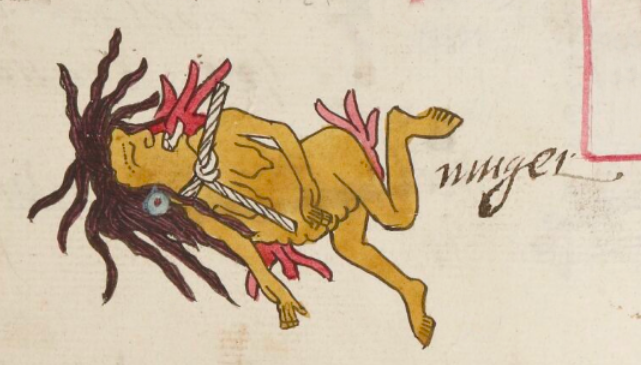tepanyaqui (TR17r)
This iconographic example from the Codex Telleriano-Remensis shows a horizontal, deceased woman who has been garroted, strangled by a white cord or rope. She is shown in a frontal (a twisted body), semi-profile view (her face). She is naked but still wears what appears to be a round turquoise ear plug. She has red blood emerging from her mouth, her side, and her bottom. Her tongue is white and protruding, and her white teeth are visible. Her one visible eye is closed. Her hair is long and separated into perhaps twelve wavy clumps, somewhat wildly displayed. Her stomach has folds that suggest she has borne children.
Stephanie Wood
The gloss conveys that this woman was executed for adultery. Alonso de Molina provides the term for adulterer, tepanyaqui, which we have applied here.
Stephanie Wood
adulterio
ca. 1550–1563
Jeff Haskett-Wood and Stephanie Wood
crime, crimen, adulterio, adultery, men, women, hombres, mujeres, blood, sangre, eztli, matar, morir, muerte, strangulation, strangled, estrangulación, estrangulada, ejecutar, ejecución, paliza, escarmiento, castigo
tepanyaqui, an adulterer, https://nahuatl.wired-humanities.org/content/tepanyaqui
la adultera
Stephanie Wood
Telleriano-Remensis Codex, folio 17 recto, MS Mexicain 385, Gallica digital collection, https://gallica.bnf.fr/ark:/12148/btv1b8458267s/f59.item.zoom
The non-commercial reuse of images from the Bibliothèque nationale de France is free as long as the user is in compliance with the legislation in force and provides the citation: “Source gallica.bnf.fr / Bibliothèque nationale de France” or “Source gallica.bnf.fr / BnF.”


